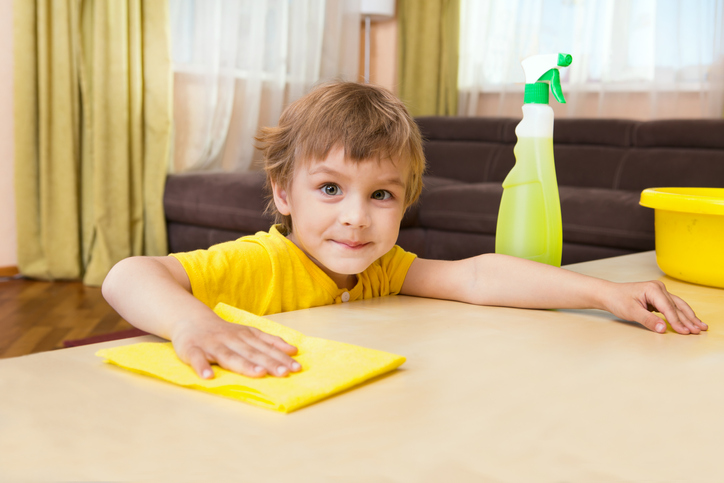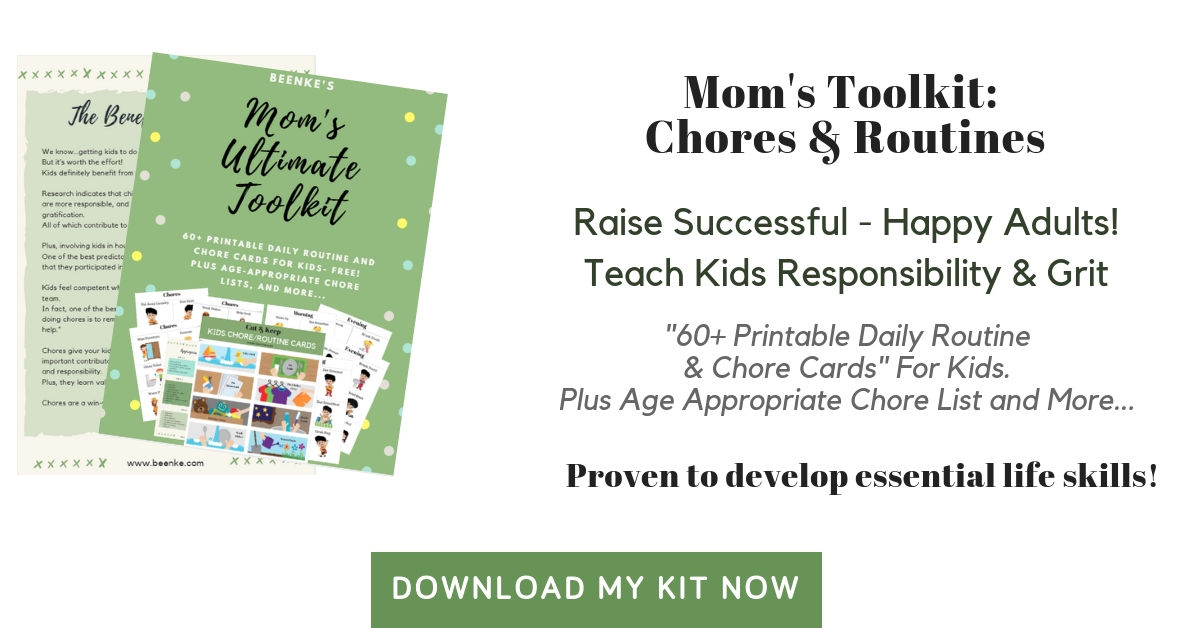Do you struggle to get your kids to pitch in around the house, or even to figure out what chores they should be doing?
If you’re nodding yes, you’re not alone. Which is why we want to tell you about the magic of using a chore chart for kids.
As parents, one of our most important jobs is teaching our kids responsibility so that they grow up to become contributing members of society. One great way to do this is by assigning chores for kids.
“It’s not what you do for your children, but what you have taught them to do for themselves, that will make them successful human beings.” Ann Landers
The trick for getting kids comfortable with helping run a household, is to get them started early. Kids as young as three can pitch in and help!
If you start them young, chores become habit… like brushing your teeth or getting dressed in the morning.
Plus kids, especially little kids, actually LIKE to help! They get a sense of satisfaction when they complete a task which can help boost self-confidence.
Studies show that children who do chores have higher self-esteem, are more responsible, and are better able to deal with frustration and delay gratification, all of which contribute to greater success in school.
In addition, involving kids in household chores has a positive impact later in life. One of the best predictors of young adults’ success in their mid-20’s was that they participated in household chores when young.
Related: Why Chores Help Kids More Than You Think
And seriously, do you want to be picking up after your kids ALL the time? No, of course not.
Doing everything for your kids doesn’t serve them or you.
So now that we all agree that chores are a good thing, let’s talk about how using a chore chart for kids can help make it happen.
Chore Chart For Kids: 7 Helpful Tips
Are you a little skeptical that your children will actually use a chore chart? Yea, so were we.
In fact, we think a lot of parents don’t bother trying to implement a chore chart system because they don’t think a family chore chart will actually get used. It’s a valid concern.
But if you put in a little prep work and set your chore system up right from the get-go, you’ll find the kids totally buy-in to the process and use it consistently.
There are a couple of things you want to keep in mind when it creating and using a chore chart for kids. These 7 tips can help your family achieve chore success!
1. Let Your Kids Help
Get your kids involved in the chore planning process! This is a great way to ensure you get their buy-in.
Ask how they think they system should work. When should all the daily chores be completed? What happens if someone doesn’t finish their assigned tasks?
Where should the chore chart for kids be displayed? How will chores get marked off when they are finished?
If a particular child is reluctant about chores, you can even offer them a choice between two or three tasks and give them ownership of that job.
When children are involved in the decision-making process, it gives them more of a sense of ownership and there is more motivation to complete the task.
2. Be Age Appropriate
While you want to get kids started on chores when they’re young, you want to make sure the tasks you assign are not too complicated for their age.
A 3-year old can certainly pick up their dirty clothes and put them in the hamper, but they would be too young to wash, fold and put away those same clothes. This is why you want to consider your chore chart by age.
If you’re not sure about a particular task, you can always try it and see how it goes.
You might find your child handles it well. In which case, keep it on their schedule!
If it seems like they aren’t ready, change up their jobs the following week.
It’s all about what works for your household and each individual child.
3. Keep It Visible And Fun!
It’s important your child can see the chore chart to keep track of what they’re responsible for, so be sure to put it at kid eye-level someplace they will walk past daily.
You’ll also need to remind them to update their chart and indicate when a task has been completed. Particularly for the first few weeks until it becomes habit.
You’ll find your kids actually like checking off the items they’ve finished. It gives them a sense of satisfaction and pride for a job well done.
Keep things fun by adding creative elements like stickers, bright colors, glitter, or cartoon characters.
Another way to liven up a chore chart for kids is to include a little surprise now and then.
Put a little sticky note on there one day that says “if chores are complete by dinner, you get to watch a movie”. Or leave a sheet of stickers taped to the chart as a little bonus for all their hard work.
Trust us, they’ll start checking the chart more often if they think there might be something new to see!
4. Determine Rewards And Consequences
We’re big believers in doing chores because they contribute to the family and not for monetary reward. But that doesn’t mean you can’t incentivize chores in other ways.
Maybe if your kids complete all their chores they get to have a movie night at the end of the month, or ice cream sundaes, or a Xbox game night.
You know what motivates your kids. And if you don’t, you can just ask!
We’re sure they’ll come up with some fun activity they’d like to do at the end of the month if they complete all their assigned tasks.
Conversely, you need to come up with what the consequence will be for any child who doesn’t complete all their chores in a given time period. Maybe they lose out on a fun planned activity, or they lose screen time or some other privilege.
Be sure your children know up front what the consequences of not completing their chores will be so their expectations are set.
Chores are a way to teach kids accountability. One way they learn this lesson is by experiencing the negative consequences of not completing the tasks they are responsible for.

5. Train Them
Just like any employee who starts a new job, your kids aren’t automatically going to know how to do all the jobs you assign them. You have to train them!
Show them how you want a particular task to be completed. And then watch them the first few times until they get the hang of it.
Kids learn visually, so seeing you demonstrate how to do something properly will always get better results than you just telling them what to do.
6. Be A Role Model
Kids are mimics. They watch everything you do and will copy it. So if they see you slacking off on days you’re should be doing your adult chores, they’ll think they can slack off too.
But if they see you taking care of business and getting your stuff done, they’ll be motivated to do the same.
7. Don’t Overwhelm Them
Chores are important for kids, but you don’t want to assign so many that it becomes burdensome. Your house isn’t a labor camp!
Think about how much time your child can reasonably spend doing chores in light of school, homework, practice, playtime and any other things they’ve got going on. Then don’t assign them more than they can handle.
If their task load is taking too much time, it’s okay to scale it back until you find something that works.

Download Mom’s Ultimate Toolkit
To help you on your quest to establish regular routines and chores in your household, we put together “Mom’s Ultimate Toolkit”.
Inside you’ll find helpful information, tips, and visual reminders you can use to set your kids on the path to responsibility.
Chore Chart Ideas:
You don’t need a fancy chore chart template to make something that works for your family. You can easily put together a workable chore chart for kids with simple cards like the ones we provide in our toolkit.
Here’s a couple of ideas to help get you started.
Poster Boards:
If you’re crafty, you can get individual poster boards for each kid and have them glue the chores that are assigned to them onto their boards. Then you and the kids get to personalize and decorate them!
Use favorite colors, glitter, feathers, heck… you can even bedazzle them. If the boards are cute, your kiddos will look at them more which is what you want. A daily visual reminder to get those chores done.
Bulletin Boards:
For us less crafty mamas, a bulletin board is another great option.
Hang individual bulletin boards in each child’s room. Label the left of the board “to do” and the right side of the board “completed”. And put some kind of dividing line down the center of the board.
You can pin all their assigned tasks on the left side of the board. Then as your child completes each task, they pin it over on the right.
By the end of the day or week, all chores should be moved to the “completed” side.
You’ve just built your own awesome chore chart for kids!
Fridge Magnets:
You can do something similar by sticking the chore cards on your fridge using magnets. Have one side set as “assigned” and one as “completed”.
Your child can move the chore cards from left to right or top to bottom as they complete each task.
Velcro Covers:
Another neat trick we saw a fellow mom do is she glued small velcro pieces to each chore card. Then she cut rectangles out of construction paper approximately the same size and glued the other side of the velcro to the blank cards.
Whether the chore cards are on a poster board or bulletin board, your kids just cover the chore with the blank card when they complete a task. By the end of the day/week all the chores should be covered!
Get creative! Make a chore chart for kids that’s going to work for your family.
By giving kids a taste of responsibility when they’re young, you’re sowing the seeds for a lifetime of independence and accountability.
SHARE our tips for using and creating chore chart for kids On Facebook and Pinterest by clicking the buttons below.













